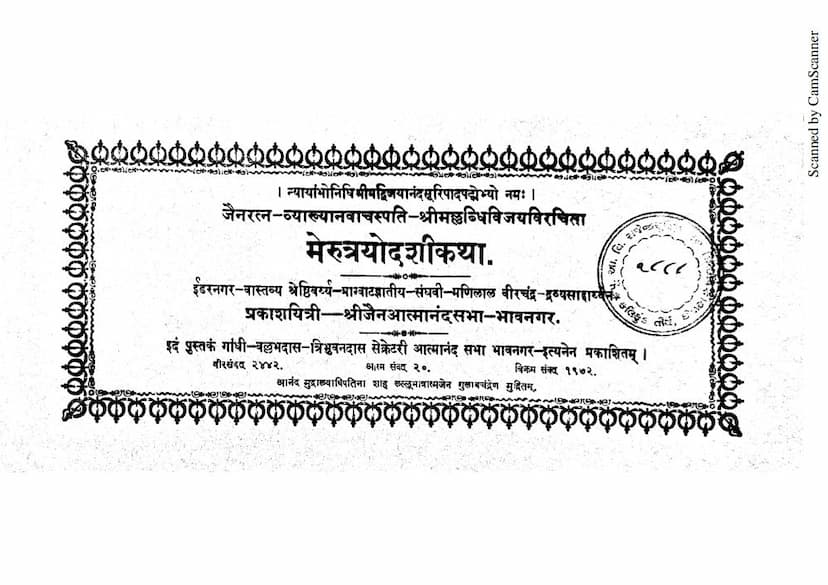Merutrayodashi Katha
Added to library: September 2, 2025

Summary
Here's a comprehensive summary of the Jain text "Merutrayodashi Katha" by Labdhivijay, based on the provided pages:
Overall Purpose and Context:
The "Merutrayodashi Katha" is a narrative text composed in a poetic (padyaroopa) style. It aims to elaborate on the significance of the Merutrayodashi (likely a specific observance or day in the Jain calendar) and its benefits for all beings. The work is presented as a devotional offering and a guide to spiritual practices, drawing upon the teachings of esteemed Jain monks. It's published by the Jain Atmanand Sabha, Bhavnagar, with financial assistance from various individuals and patrons.
Key Figures and Lineage:
The text is dedicated to the feet of Shrimad Vijayanand Surishwar and is composed by Munivarya Shrimad Labdhivijay. Labdhivijay is described as "Jainratna-Vyākhyānavācaspati" (a title signifying mastery in Jain discourse) and was inspired by Munivarya Shrimad Manavijay. The lineage of spiritual guidance traces back through Shrimad Vijaya Kamal Surishwar, who followed Shrimad Vijayanand Surishwar.
The Narrative and its Moral Core:
The central narrative revolves around King Anantvirya of Ayodhya, who, despite his prosperity and a beautiful queen (Priyamati), suffers from the absence of a son. A sage predicts that his future son will be a cripple. This prediction comes true with the birth of Pingalaraya.
The story then introduces Gunā Sundari, the daughter of King Shataratha of Brahmapura. Several merchants, on their way back from Ayodhya, learn of the king's search for a suitable groom for Gunā Sundari and offer Pingalaraya's hand in marriage, describing him as handsome and noble, but concealing his physical disability.
Upon hearing of the proposed marriage, King Anantvirya and his minister are concerned about Pingalaraya's disability and how to present him. They concoct a story about him residing with his maternal uncle in a distant town. Meanwhile, the king of Brahmapura sends emissaries to Ayodhya for the marriage.
The Intervention of Muni Gangila and the Teachings:
At this juncture, Muni Gangila, a monk possessing "chatur-jnana" (four types of knowledge), arrives. The king seeks his guidance. Muni Gangila delivers a profound discourse on Jain principles, emphasizing:
- The rarity and value of human birth: Human life is the only opportunity for spiritual progress.
- The impermanence of life and worldly possessions: Everything is transient.
- The suffering of the cycle of birth and death (samsara): This cycle involves countless rebirths in various forms.
- The importance of compassion (daya) and self-control (samyama): These are the foundations of dharma.
- The dangers of attachment to sensual pleasures (vishaya): These lead to suffering and hinder spiritual liberation.
- The virtue of truthfulness (satya): Speaking truth leads to auspiciousness and liberation.
- The four pillars of dharma: dana (charity), sheel (virtue/conduct), tappah (austerity), and bhava (meditation/contemplation).
- The twelve Bhavanas (meditations): These are key contemplative practices for spiritual purification and detachment, including:
- Anitya (impermanence)
- Asharana (helplessness)
- Samsara (cycle of existence)
- Ekatva (oneness/solitude)
- Anyatva (otherness/non-possession)
- Ashuchi (impurity)
- Ashrava (influx of karma)
- Samvara (cessation of karma)
- Nirjara (shedding of karma)
- Loka (the universe)
- Bodhi Durlabha (difficulty of attaining enlightenment)
- Dharma (the true nature of dharma)
The Cause of Pingalaraya's Condition and the Solution:
Muni Gangila reveals the past life story of Pingalaraya's former birth. He was Samantasimha, the son of King Mahendradhvaja. Samantasimha became addicted to gambling and theft, even stealing from the temple treasury. As a consequence of his actions, especially the theft of temple ornaments and the cruel act of severing the legs of a deer, he was cursed by ascetics to be born as a cripple.
The sage explains that the reason Pingalaraya was born with crippled feet was due to his past karma: destroying temple wealth and injuring a deer.
The solution prescribed by Muni Gangila for the cure of Pingalaraya's condition and the attainment of spiritual merit is the observance of Merutrayodashi. This involves:
- Fasting on the auspicious day of Magha Krishna Trayodashi.
- Worshipping the Meru Panchaka (five sacred mountains) and placing them before the Jina images.
- Performing Puja (worship) with incense, lamps, and other offerings for thirteen months, or for a year.
- Chanting the mantra "Om Hrim Shri Rishabhadeva Parangataya Namah" a thousand times.
- Observing Atithisansvibhaga (offering food to monks and the needy) before breaking the fast.
The Outcome and Spiritual Attainment:
King Anantvirya diligently observes the Merutrayodashi ritual with his son. As a result, Pingalaraya's feet are restored. He marries Gunā Sundari and later, King Anantvirya renounces the world, takes diksha (initiation) from Muni Gangila, and eventually attains Kevala Jnana (omniscience) and Moksha (liberation). Pingalaraya also lives righteously, rules his kingdom, and ultimately follows his father into renunciation and spiritual attainment.
The Significance of Merutrayodashi:
The narrative strongly emphasizes the efficacy of the Merutrayodashi vrata (vow) in rectifying past karmic offenses and bringing about positive transformation, both in this life and for future births. The text highlights the merits of performing this ritual with faith and devotion.
Concluding Remarks and Homage:
The text concludes with an ode to the virtues of the lineage of gurus, particularly Shrimad Vijayanand Surishwar and Shrimad Vijaya Kamal Surishwar. It reiterates the enduring merit of the Merutrayodashi observance and encourages readers to engage in it for their well-being and spiritual progress. The composition is attributed to Labdhivijay with the inspiration and guidance of his spiritual predecessors.